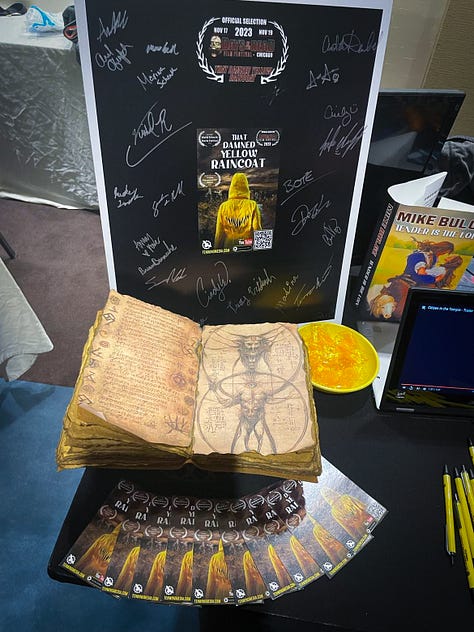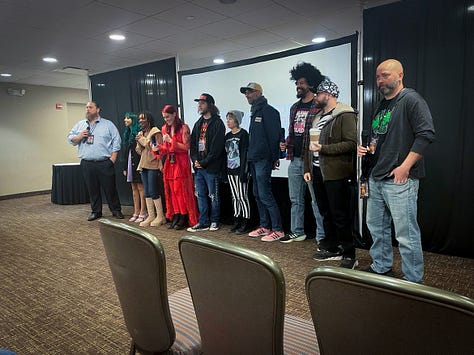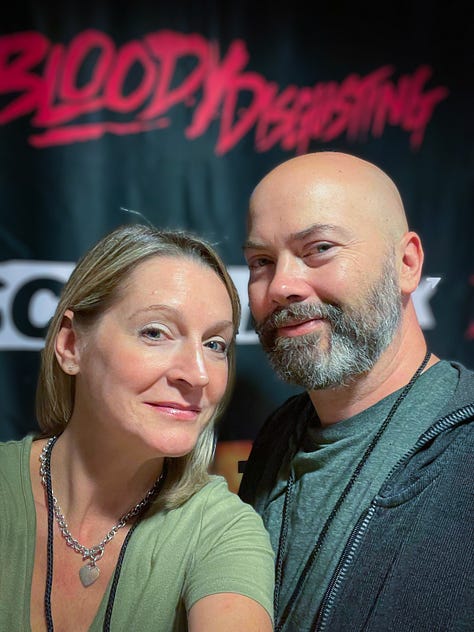From Short Film to Universe: How a Cross-Media Strategy Amplified My Story's Impact
The first thing I can remember wanting to be was a fiction writer. Growing up, I constantly wrote, developed ideas, and played an unhealthy amount of Dungeons & Dragons. In the early 2000s, when my friends and I got our hands on digital cameras, I funneled my passion for writing into filmmaking. I love both mediums and constantly feel pulled to develop in each. Over the years I earned an M.F.A. in Digital Cinema, made a handful of shorts, a feature film and got published in several anthologies.
Things naturally slowed down with the emergence of COVID but last year I developed a short story meant to knock the rust off and strengthen my resume, both as a horror author and a filmmaker. It was called That Damned Yellow Raincoat. It is about a disenchanted suburban man who becomes obsessed with a woman in a yellow raincoat that keeps passing by his home. My plan was to make the film, write the fiction version and distribute both in whatever way I could.
In today’s media landscape it is easier than ever to distribute a creative product but harder than ever to market it. Musicians, filmmakers and writers are all in the same boat. It’s tough to get noticed with all the media constantly being thrown at us. Everyone has their own streaming service (sign up for Costco+ now!). There is more YouTube content uploaded every day than a person could watch in their entire lifetime. It’s a lot! By adopting a cross-media strategy I hoped to have more opportunities to talk about my story, raise awareness and connect it to a larger community.
At the time of writing this, I feel like That Damned Yellow Raincoat was a massive success. Over the course of a year I shot the film, got it into festivals and got the fiction version published in a magazine. Here I will share the steps I took, the strategies I used and what I plan to do with the story in the future. Hopefully it will either give you some ideas for your own work… or make you say “Hell no. I’m not doing that.”
TIMELINE
1. Writing the Screenplay
First I wrote that Damned Yellow screenplay. It was eight pages long. I committed to only using one location- the house of valued friends who understood what it meant to let a film crew through the front door. The story was small in scope. It was something I could film in a single day with three actors. Indie filmmakers know that even with a small cast and crew, logistics can be a beast. I didn’t want things to go haywire in terms of scheduling. I got the cast and crew through my contact network that I’d developed over the years, no casting call. I knew what experience they brought to the table and I was confident that they would be fantastic, and they were!
2. Short Film Production
Next I shot the short film. Again, one day of production. It was essential to keep the scope small. I’ve been a part of many projects that took years to complete and I wanted That Damned Yellow Raincoat to be something I could wrap up and push out to the world in a reasonable amount of time.
3. Post-Production and Fiction Writing
I knew the post production process would take longer than usual because I was doing all of the VFX myself. I didn’t mind and that was a fun few months of learning. Before we started shooting I had a game plan (or YouTube tutorial) for every effect I wanted to try. Only one shot didn’t go as planned but I had a safety net to achieve the same narrative impact.
While I was editing the film, I wrote the fiction version. It was interesting to go from the screenplay, to the actors’ performances, back to the page. I enjoyed writing the prose while hearing their voices but for my next project I would reverse the process and finish the fiction first. Actors do a lot of work to create a character’s life outside the page and most of the time a screenplay format doesn’t allow for much inner dialogue. It mostly speaks in action. As a director I can think of no clearer way to communicate my perspective on character motivations than to provide a prose version alongside the screenplay.
4. Submitting to Festivals
I’m glossing over about a year of post-production work and elation over being finished with my first film project since 2015, but we’re talking about results here! When the film was done I sent it to festivals via a profile I created on FilmFreeway. I didn’t go wild with submissions. It’s very easy to spend a lot of money. Out of 11 festivals, I was turned down by 5, accepted to 3 and I’m still waiting to hear back from the other 3.
The first festival That Damned Yellow Raincoat was accepted to was the World Drive-In Movie Festival with Joe Bob Briggs. Joe Bob and his cohost Darcy the Mail Girl host The Last Drive-In on Shudder and Joe Bob has been a b-movie icon for 40 years. Getting into that festival immediately connected the film to his audience and helped get more attention on the movie even after the festival. I won the coveted Hubbie Award, which is an award inscribed on a real Chevy hubcap! After that fest, I was accepted into Tri-Cities International Film Festival and Days of the Dead International Film Festival in Chicago. All of these qualified the film for an IMDB page, which is not strictly necessary but it’s a nice badge of authenticity and can help your movie get picked up if you decide to self-distribute through services such as Filmhub.
5. Fiction Submission
While the film played at festivals, I sent the story out for publication. I submitted to around 25 different places. No one pays much for short fiction, but I focused on paid horror markets first. However, more than money, my primary concern for this story was getting a publishing credit to build my resume. Most publications accept less than 2% of submissions so I received a lot of rejection letters.
6. Posting and Sharing
Throughout this entire process, I released behind the scenes photos and updates across all my social media channels- Facebook, Instagram, Twitter, and Threads. I even started using the YouTube Community tab on my Ten Wing Media channel. I don’t have TikTok. I drew a line a long time ago but people tell me I should sign up. I’ll think about it. If any of you creatives have a compelling argument for or against Tiktok, feel free to sound off in the comments.
This was a good project to brainstorm different types of social media content. What makes a good reel, YouTube short, or standard post? I had a hangup in the past where I felt like I was spamming people any time I posted about a project, even though it wasn’t that often. But no one has yelled at me yet, and I don’t overdo it. Historically I’ve been someone who keeps the creative process close and quiet. I never liked talking about something until it was finished so it has been an adjustment for me to learn how to regularly share my process.
7. YouTube Film Release
After the first batch of festivals concluded, I released That Damned Yellow Raincoat on YouTube. I made sure that the remaining festivals had no issue with the film being publicly available prior to any potential future screenings. Some don’t like that. I shared the film across all my channels, encouraged the cast and crew to share and reached out personally to people, asking them to watch. I also posted the film in relevant online communities such as The Last Drive-In Facebook group. They already had a bit of exposure to the film so I feel like that helped the numbers right after launch.
When I uploaded the film, I spent time designing a strong thumbnail for YouTube and filled out as much metadata as accurately as possible. I wanted to do everything I could to be in the good grace of the almighty algorithm.
8. Published in Pyre Magazine
Shortly after the film went live on YouTube I got word that the story was accepted into Pyre Magazine. It paid a small amount and would appear in both print and online versions of the publication. That’s the best I could have hoped for.
MISSION ACCOMPLISHED
With that, my personal mission of getting the story into festivals and published was accomplished. The entire process took over a year. It could have gone faster but I worked with almost no budget.
BENEFITS
So what were the benefits of a cross-media strategy? Since the film is still on the festival circuit and the story was only recently published, some questions remain. However here are my takeaways so far…
Creating a film has opened up opportunities for travel. At this stage in my filmmaking career, I’m not looking to run off to Hollywood but I do enjoy traveling to film festivals and conventions and interacting directly with fans that are into the same things I am. The film version gave me a good reason to be in those places with something of my own to talk about. I do regret not getting to Las Vegas for the World Drive-In Movie Festival, but that trip would have been financially irresponsible. I had an absolute blast at Days of the Dead Chicago. The film introduced me to a great con staff there as well as other local filmmakers. Days of the Dead even provided table space for filmmakers, so I had a home base in the dealer room to discuss my project with the thousands of attendees. I’m thrilled to have been a part of that and I plan to be a returning visitor.






Another benefit of working on the film was bringing together my friends again and meeting a few new ones. I feel like the best way to be an indie filmmaker is to grow a network you respect. That Damned Yellow Raincoat introduced me to more people I would definitely like to work with again in the future.
Recently, I was asked to be a guest on the Horror Pop After Midnight podcast. I was given the opportunity to discuss the story and connect with that audience. I think interviews and podcasts are good practice for talking about yourself and your work. Some writers, myself included, haven’t always been great at that.
Right now I believe YouTube is the future of self-distribution for indie filmmakers and I think it could have a role to play for authors as well. I was able to use both the film and the story to continue building my YouTube channel. It is a very slow process but releasing the film, behind the scenes bits and short clips have led to an increase in subscriber count and watch hours.
Lastly, I am now able to list Pyre Magazine among my publishing credentials on my resume and future cover letters. It does help the appearance of professionalism when you can point out that someone has valued your work enough to purchase it. It’s another building block in the author profile.
WHAT’S NEXT?
So where do I go from here? The author contract I signed with Pyre ties up the story for six months. After that I plan to self-publish it and release the audiobook. I hope to have that ready around May or June 2024. My film festival run hopefully won’t conclude until the end of 2024. I will continue to use That Damned Yellow Raincoat to meet new horror fans and hopefully the different versions will continue to promote one another.
The cross-media strategy would likely be too expensive and time consuming to do with a novel and feature film but I plan to continue doing this with my short work. Cross-media requires you to spend more time with a project but I subscribe to the mindset that “the work is the reward” so I enjoy having a longer timeline. I feel very fortunate and fulfilled just to be able to sit at a coffee shop and write a story or a screenplay. I love being able to work with a crew to make a film. So if I get to do those things, I’ve already won. Everything else is icing on the cake. I’m thankful that this story has given me so much icing. I’ve taken a 3,500 word story and an 8-minute film further than I thought possible. And I’m not done yet! I plan to expand the mythology introduced in That Damned Yellow Raincoat as well as release more stories in 2024. I have discovered that with a cross-media strategy, there are more steps in the creative process to share, which lead to more conversations, which hopefully will lead to community building over time.
I hope this helped you in some small way. If you have any thoughts, questions or would like me to elaborate on anything above, please feel free to comment.
Thank you for reading this.
Jason










